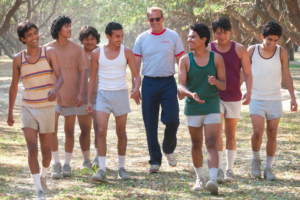
The Utopian Elements of McFarland, USA
Jessie Hem
11/13/17
English 117 Essay 2
The Utopian Elements of McFarland, USA

Popular culture often provides an escape from the real world by allowing us to become absorbed in a fictional society. These “worlds” sometimes show a better version of our own and could therefore be considered utopian. Utopias can also be demonstrated in unexpected places such as zombie movies which at first glance appear to be dystopian in that they typically depict the end of the world. However, after more careful examination, they can be seen to have utopian aspects as they show the freedom people have once societal rules and norms are taken away by an apocalypse. The movie, McFarland, USA also demonstrates the idea that utopian elements can be found in surprising places. McFarland, USA was released in 2015 and is based off of a true story. The movie follows Jim White, a former high school football coach, as he attempts to turn an impoverished group of Mexican immigrants into a championship cross country team. White becomes inspired watching the group of boys run from the fields where they work to school every morning and convinces the school to allow him to start the team. The setting, plot, characters of the movie appear to be far from ideal. However, the movie contains elements of utopia in the seemingly non-utopian setting of McFarland, California.
One aspect of this movie that is utopian is that the McFarland boys are able to overcome great obstacles and win a state championship. They come from the non-utopian environment of impoverished families of Mexican immigrants most of whom work as migrant field laborers. The boys on the team work every morning before school and on the weekends along side their families thus making it difficult for them to train as much as their competition. Due to the poor financial state of their school, the team can also not afford proper running shoes or uniforms. At the beginning of the season, the boys have to wear handmade uniforms sown by their mothers and White has to buy them running shoes with his own money. Despite the challenges the McFarland team faces, they are still able to find a utopia by overcoming their struggles ultimately winning a championship.
Marit Boker explores the idea of a realistic utopia in his essay “The Concept of a Realistic Utopia: Ideal Theory as Critique.” Boker discusses how John Rawl, a professor at Stanford University who specialized in political philosophy, describes a realistic utopia stating, “A realistic utopia… is a vision of society that rests upon assumptions of the real possibilities of humans, but goes beyond existing social arrangements with the aim of overcoming the evils of unjust war, oppression, religious persecution, and slavery, telling us that this is where we ‘ought to want to be.’” (Boker). The McFarland cross country team is able to overcome the oppression they face in their day to day lives by coming together as a team and winning a championship. The movie also shows us a version of an ideal society as different teams representing different areas of California with different racial and economic backgrounds, come together to compete, gaining respect for each other in the process. Therefore, the movie, which has a plot centered around the far from ideal circumstances of the McFarland cross country team, shows utopia in the idea that impoverished immigrants like the McFarland boys are able to rise above their social position and compete equally with their more privileged opponents.
The movie also shows the utopian idea of people of different races and cultures living together in harmony in the non-utopian environment of an economically depressed town. Jim White moves his wealthy white family from suburban Idaho to the foreign town of McFarland, California. Upon arrival to the town, his youngest daughter, Jamie, looks out the window and asks, “Are we in Mexico?” The Whites are unfamiliar with the town and its people making them uncomfortable at first. They even leave a restaurant when a group of people drive up in painted cars and act gang-like. Later on in the movie, the White’s car breaks down and they end up getting help from this group of people who they had initially thought to be a dangerous gang. It turns out this group just really enjoys cars and the Whites become friends with them. This friendship begins the White’s integration into the McFarland community which is exemplified when the town decides to throw a quinceanera for Julie, White’s oldest daughter. The fact that they incorporate one of the only white families in the town into their latino tradition shows that the Whites are now living in harmony alongside the people of McFarland.
The Whites newfound comfort in McFarland is utopian in that it shows that people of vastly different backgrounds can both live together and be friends. It is common in our society for people to live with those who share their race or culture as seen by the traditionally Black, Asian, Latino, Italian, and other culturally or racially segregated neighborhoods present in most cities. These neighborhoods create a larger cultural divide between groups of people as they are rarely exposed to aspects of a culture different from their own. The lack of exposure to different races and cultures contribute to much of the stereotyping and racism in our culture today. McFarland, USA shows that exposure to different cultures leads to great friendships and experiences thus demonstrating the ideas of Rawl that a utopian world involves overcoming existing social barriers and exemplifies a better version of our current society. The Whites appear to be in a non-utopian environment as they are outsiders in the town because they are both newcomers and white. However, the movie demonstrates that they can find utopia in seemingly non-utopian environment by not making quick judgements of their new neighbors and being open to making new friends.
The movie also contains the utopian idea that a lack of money can lead to cohesiveness and camaraderie among members of group. The people of McFarland are very poor. They mostly work low income jobs like migrant field labor thus creating an unstable financial situation for most families. Despite their poverty, the people of McFarland are both welcoming to the Whites and kind to each other. One example of the strong community is the car wash scene in the movie. They boys on the cross country team need to raise money for transportation to the state meet. The people of McFarland hear about this struggle and decide to help the team by organizing and working a car wash. This task involves a decent amount of time that these people could spend working to make money for their families. However, they sacrifice their time to help the boys raise enough money to go to states. Another example of the selflessness in McFarland is when White is invited to dinner by three of his runners, Danny, David, and Demacio Diaz. Their family struggles financially and doesn’t always have enough food. However, when White comes to dinner they serve him several helpings and even give him the leftovers to take home to his family.
The idea that people are happier and more unified in poorer environments is utopic. In the introduction to her her book, Everyday Utopias: the Conceptual Life of Promising Spaces, Davina Cooper explained that Utopias, “work by creating the change they wish to encounter, building and forging new ways of experiencing social and political life”(Cooper 2). In McFarland, USA, the seemingly non-utopic poor town actually leads to a utopia in that it causes people to be kinder and more helpful towards each other as exemplified by the car wash and the dinner at the Diaz’s. The movie implies that you don’t need money to be happy and even that the absence of money can be a good thing as it brings people closer together. This idea goes along with Cooper’s idea of a realistic utopia in that changes the way we view money by shining a positive light on people of lower financial status. The movie also fosters new ways of thinking about those generally considered to be of low social or political status. The movie portrays the people of McFarland as more than just poor migrant workers by deeply developing their characters and showing the complex relationships between the people in the town. McFarland, USA, therefore finds utopia in poverty by showing how it created a cohesiveness among the people in the town.
McFarland, USA demonstrates utopian aspects in seemingly non-utopian environment. McFarland is only one small town but it can be used as a representation of the larger problem of the poverty cycle and lack of opportunity in our society today. The movie demonstrates utopia in the non-ideal town of McFarland by showing that poor people like the boys on the cross country team are capable of rising up in society and gaining the respect of those who are wealthier than them. It also demonstrates utopia in that is shows that people of vastly different backgrounds and cultures can live together in harmony, and that a lack of money creates camaraderie within a group of people. In his essay, Boker quotes Ruth Levitas, a professor of sociology at the University of Bristol, saying, “One person’s utopia may be another person’s hell”(Boker). This idea is demonstrated in McFarland, USA as some of the utopian aspects of the movie are not utopian for everyone. By winning the state championship, the boys are given opportunities that most other people in the town will never receive due to factors that they cannot control like athletic ability, age, or gender. For example, it would be very difficult for a young girl to watch her male counterparts get the opportunity to go to college because of their running ability. She would not have been given neither the opportunity to try running as there is no girls team, nor the opportunity to utilize a different skill she might have to lead to her success. Therefore, what is a utopia for these boys, would be a “hell” for the girl. If it is true that what is considered an ideal aspect of society differs for every person, we can then question if it is possible for a true utopia to actually exist.
This essay was read by Oriana Cruz. It is not a first draft.
Works Cited
Boker, Marit. “The Concept of Realistic Utopia: Ideal Theory as Critique.”Constellations, vol. 24, no. 1, 2015, pp. 89–100., doi:10.1111/1467-8675.12183.
Cooper, Davina. Everyday Utopias: the Conceptual Life of Promising Spaces. Duke University Press, 2014.